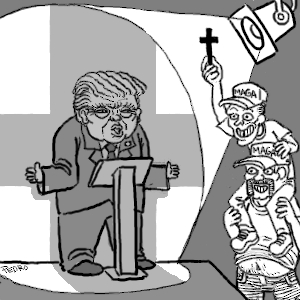Trump and Trumpism: An American Brand of Fascism
All too often, pundits depict Trump and Trumpism as a unique expression of political extremism, but Trumpism is not entirely unique. When the defining characteristics of his campaign were made public in 2016, Trump and Trumpism began to amplify forms of hate and violence that were pre-existing in the political culture of the United States. There is no denying that there are novel aspects to Trump and Trumpism, which derive from ongoing historical expression of extreme forms of hate and violence. It is a lengthy history in which hate and violence has been used consistently to demonize various social segments, such as indigenous people, people of color, women and organized labor and employed and expressed as various isms, racism, sexism and anti-Semitism. These isms are a reaction against what is perceived to be threats to the ideal image of an America that consists of upper-class whites, dominated by males.

Artist: Pedro Camargo
From the moment Trump descended the escalator to launch his campaign for the presidency, he identified the non-white threat to the United States. On his first day in office, the hate-driven political agenda unfolded with the signing of his executive order to remove the mandates of the Affordable Care Act, followed by another executive order to remove Federal Housing Administration mortgage discounts for low-income buyers. His January 25, 2017 executive order mandated the construction of a 2,000-mile wall along the southern border of the United States in order to keep migrants out. His anti-Semitism was evident in his remarks after the Charlotte Unite the Right rally. The Access Hollywood tape along with his selection of three Supreme Court justices who could be counted on to overturn Roe v. Wade revealed the depth of his inability to tolerate women controlling their bodies. His racism is evident in his attacks on demonstrators who protested the murder of George Floyd with his remark, “When the looting starts, the shooting starts.”
There is a segment of the middle class that responds to his instigation of violence at rallies where his intent is to whip the crowd into a hate-filled frenzy. As former Black Panther H. Rap Brown put it, “Violence is as American as cherry pie.” In the U.S., violence has been and continues to be normalized in such things as the prevalence of violent sports, America’s global military presence and a lengthy history of invading and supporting the overthrow of governments overseas. The United States is a global leader in the production and distribution of weapons, which translates domestically into violence being expressed as a might makes right culture.
Trumpism has manifested itself as an extreme form of destructive politics, the goal of which is to cause harm to various social segments. Trump’s appeal to segments of the middle class was made clear during his inaugural speech when he said, “This American carnage stops here and stops right now.” He was signaling not only that he recognized their historic decline but that he was going to be the one who would be able to reverse it. It was the beginning of the clear symbiotic relationship between Trump and his followers, epitomizing the ties forged between Trump and the Trumpists, a base that consists of parts of America’s middle class.
Trump’s social base consists of these parts of the middle class as well as members of the upper classes, according to media reports of exit polls of the 2016 and 2020 elections. Similarly, the Washington Post in 2019 ran an article headlined, “White Trump voters are richer than they appear,” and they identify and support policies that benefit the upper class. The willingness to follow Trump no matter what is based on a deeply held belief that Trump will be able to achieve a dystopian destruction that will undermine the diverse social segments that parts of the middle class see as threats and will ultimately result in the middle class returning to its former glory.
There is something truthful in the perception of middle-class decline; Trump has effectively tapped into and exploited the rage the middle class has against its own decline. In so doing, Trump positions himself as the savior of this declining middle class while scapegoating various diverse social segments as the cause behind this precipitous decline. The MAGA base puts its unquestioning blind trust in the belief that Trump will somehow rescue the middle class. The bulk of Trump voters are members of the fearful, declining middle class segments that historically have functioned as the political backbone of fascism.
While Trump has been effective in manipulating the fears and hopes of this middle class segment by scapegoating social segments, the mobilization of support for Trump also functions as a political smokescreen for his policies, which are designed to almost exclusively benefit the upper classes. One indication that this is where Trump’s emphasis lies is in his handpicking billionaires as his advisors and policymakers: Linda McMahon, Betsy DeVos, Wilbur Ross, Todd Ricketts and Gary Cohen, all drawn from the upmost echelons of corporate America.
While extreme forms of hatred and violence against diverse social segments are supported by Trumpism, the focus of his administration’s policies was to take action to deregulate the economy. In 2017, Trump claimed responsibility for 83 deregulations that expanded the greater extraction of fossil fuels and allowed companies to dump hazardous waste in rivers and streams, contributing to water pollution and creating greater threats to drinking water, not to mention hastening climate change. His Department of Agriculture deregulated policy in poultry plants and accelerated production lines, endangering the health and safety of workers, many of whom are immigrants, and consumers. He instituted many anti-labor policies, such as stacking the National Labor Relations Board with appointees who reversed the “Transparency Rule,” which allowed workers to know when employers engaged in anti-union activity. Under a new policy that he established, restaurant employers no longer had to distribute pool tips among the staff and could pocket servers’ tips.
Trump also intended to repeal and replace the Affordable Care Act. While that didn’t happen, he was able to repeal the individual mandate and reduce the advertising of the exchange and enrollment periods. In other actions taken, Trump vetoed a bill that would have allowed the government to negotiate drug costs with manufacturers. He also expressed interest in the privatizing of schools. He considered his greatest achievement his signing into law in December 2017 the Tax Cut and Jobs Act. Corporate America was the beneficiary of this a $1.9 trillion tax cut of which $1.3 trillion went into the pockets of top executives and shareholders of corporate America.
This brief sample of Trump’s two-fold agenda demonstrates how he mobilizes segments of the middle class who amplify existing forms of hatred and violence while Trump supports policies that benefit America’s upper class. The ongoing inherent danger that looms following the 2024 election are the institutional preconditions for fascism to unfold in the United States. Should Trump achieve a second term in 2024, he will implement many of the policies outlined in the GOP’s Project 2025, cementing the unity of state and corporate policymaking, which is the essence of fascism.
And Trump makes no secret of his unabashed support for corporatism. In “How America’s Oligarchy Has Paved the Road to Fascism,” Robert Reich identified the billionaires, such as Phil Ruffin, Charles Kushner, Robert Johnson, Bernie Marcus, Robert Bigelow and Scott Bessert, who have contributed billions to Trump’s 2024 presidential campaign. Trump’s support comes from segments of the middle and upper classes, which share in common a class struggle that they are waging against a heterogeneous America. However, the motivations of each of these segments differ.

Artist: Drew Martin
Trump’s mobilization of middle-class segments function as the social support for the anti-democratic fascist movement who in their blind loyalty spearheaded an attempted coup on Jan. 6, 2021. Had the coup succeeded, Trump and his followers in Congress would have cemented a merger of governmental and corporate power, which is a definition of fascism. What has blinded Trump’s followers is the overriding myth of the ruler who governs by the force of his will and is not bound by the rule of law. A suspension of law by the Enabling Act put Hitler above the law and bears a striking similarity to Trump’s argument in the courts for his immunity from prosecution. Trump’s intention to assume dictatorial authority is stated in his recent remarks to the media that he would be “a dictator for one day” once elected.
Trump’s mindset echoes the writing of Carl Schmitt, who expressed in his book Political Theology, the idea of “the sovereign is he who decides the exception.” For Trump, like Schmitt, sovereign authority is not to be constrained by legalism. For both Trump and Schmitt, there is no conception of a universal law existing in a constitution; there is only the sovereign who decides on the basis of what he considers to be situational law. Within the pages of Political Theology, Schmitt like Trump expresses the belief that politics is the difference between friends and enemies. It is as if Trump, who never read Schmitt, is simply attempting to realize the concept of a sovereign dictatorship. Both Trump and Schmitt have expressed admiration for Hitler.

Anti-Fascists protesting Donald Trump. (Lorie Shaull, 2017)
Part of Trump’s grand strategy to undermine the legal system, which is a key feature of fascist ideology, is his effort to delay his court cases until after the election. Upon returning to power, he can then employ the Schmittian principle that the sovereign alone decides the exception; in so doing, he can then will away the federal cases. While on the campaign trail, Trump consistently references his victimhood, which he says demonstrates that he is being legally persecuted. To drive home the point and to underscore and strengthen the political paranoia that helps cement his ties with his middle class base, he says, “They’re not after me, they are after you.”
During Trump’s time in office, 27 psychiatrists collaborated to write The Dangerous Case of Donald Trump in which they refer to his pathological narcissism and extreme paranoia. And possibly because of what numerous observers have identified as his more recent mental decline, his political paranoia has only increased. At a rally last November in New Hampshire, Trump made the following statement, evidence that his political paranoia has reached a fever pitch. “We will root out the communists, Marxists, fascists and the radical left thugs that live like vermin within the confines of our country, that lie and steal and cheat on elections and will do anything possible—they’ll do anything, whether legally or illegally, to destroy America and to destroy the American dream.” The ongoing assault on diversity that would result and the undermining of incremental advances made by women, people of color, gays, Jews, immigrants and other diverse segments sets the political tone for the continued manipulation of a fearful segment of the middle class that is prone to violence. This is also the segment that was the social and electoral base of support for fascism in Nazi Germany.
Middle class segments that support Trump are motivated by his rhetoric to act with unrestrained freedom to harm others. Trump as mythmaker instills in this segment of the middle class the idea of a reactionary return to a time of white, middle-class glory, which would be preceded by organized violence against diverse groups. These groups, have, in the view of this segment of the middle class, taken over the political culture, which they believe they had previously dominated. This misdirection away from holding corporate America responsible for this segment’s perceived decline provides a license to express a vicarious, sadistic delight at times expressed as violence as middle class fears and suffering are projected onto diverse groups. These actions find expression as creative destruction intended to cause harm to various social segments.causing harm to these segments, Trump and his followers are undermining democracy, which in turn, strengthens the position of America’s upper classes. Trump’s appeal to this part of the middle class creates a mystical union between them and Trump with a shared irrational bond which suspends critical thinking and unfolds as a form of malignant narcissism. Any idea or policy that might redefine this group identity is regarded as a threat. He has bonded with his followers by infusing them with a delusional and paranoid mindset.

Anti-fascists protesting against Trump in Tucson, Arizona.
Trump formulates policies that are designed to benefit the upper classes while at the same time expressing a political paranoia about diverse groups that appeals to the middle-class segments that support him. In terms of how he relates to those parts of the middle and upper classes, Trump’s political psychology, according to Andrew Lobaczewski, in his book Political Ponerology: A Science on the Nature of Evil Adjusted for Political Purposes, is experimental in that on an almost daily basis, he will change the manner in which he manipulates his followers. At the same time, there is consistency in the references that Trump makes to specific concepts and groups that are framed as threatening.
Trump instigates his followers to engage in creative destruction, which means to seize control and do harm to other peoples’ bodies for its own sake, a consistent element of fascist movements. One recent example is the Alabama Supreme Court ruling on in vitro fertilization (IVF), which created a legal category for fetal personhood, a striking example of women losing autonomy over their own bodies. Iowa also has moved forward with legislation on fetal personhood. This is the ripple effect that initiated by the Supreme Court’s Dobbs decision, and quickly was replicated on the state level, undermining privacy and establishing that the government has the legal authority to intervene over women’s reproductive functions. It would not at all be surprising for the Court to further undermine privacy and strike down Griswold v. Connecticut, which granted married couples the right to contraception in 1965. In fact, several justices in Dobbs said they intend to do just that.
Regardless of whether or not there is a Trump victory in 2024, the undeniable issue facing the country is the long term effect that Trump and his movement have had on putting in place the preconditions for fascism in the United States. Having learned to better make use of the levers of power, Trump’s delusional paranoia will know no limits if he wins. If, on the other hand, Biden wins, Trump has clearly instructed his base as to what their role will be. At a Buckeye Values Rally, in Dayton, Ohio on March 16, he said, “Now if I don’t get elected, it’s going to be a bloodbath for the whole — that’s gonna be the least of it. It’s going to be a bloodbath for the country. After the rally, to make sure his fascist intentions are understood, he went on Truth Social to state that as president, he must have full immunity from prosecutions. His statement is an unequivocal reflection of the Schmittian principle that the sovereign decides the exceptions by exercising a political will unrestrained by legality.

